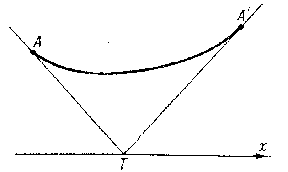Lindelöf construction
From Encyclopedia of Mathematics
A geometrical construction to find conjugate points in the problem of finding a minimal surface of revolution (see Fig.).

Figure: l058950a
Lindelöf's construction remains suitable for any variational problem of the simplest type on the  -plane for which the general integral of the Euler equation can be represented in the form
-plane for which the general integral of the Euler equation can be represented in the form
 |
The tangents to the extremals at conjugate points  and
and  intersect at some point
intersect at some point  on the
on the  -axis, and the value of the variable integral along the arc
-axis, and the value of the variable integral along the arc  is equal to its value on the polygonal line
is equal to its value on the polygonal line  (see [2]). An example is the catenoid with generating curve
(see [2]). An example is the catenoid with generating curve
 |
References
| [1] | E. Lindelöf, "Leçons de calcul des variations" , Paris (1861) |
| [2] | O. Bolza, Bull. Math. Soc. , 18 : 3 (1911) pp. 107–110 |
| [3] | C. Carathéodory, "Variationsrechnung und partielle Differentialgleichungen erster Ordnung" , Teubner (1956) |
Comments
References
| [a1] | A.E. Bryson, Y.-C. Ho, "Applied optimal control" , Blaisdell (1969) |
How to Cite This Entry:
Lindelöf construction. Encyclopedia of Mathematics. URL: http://encyclopediaofmath.org/index.php?title=Lindel%C3%B6f_construction&oldid=22749
Lindelöf construction. Encyclopedia of Mathematics. URL: http://encyclopediaofmath.org/index.php?title=Lindel%C3%B6f_construction&oldid=22749
This article was adapted from an original article by V.V. Okhrimenko (originator), which appeared in Encyclopedia of Mathematics - ISBN 1402006098. See original article